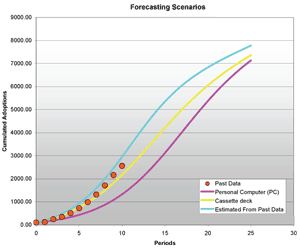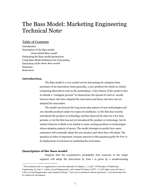| What you put in... | What you get out... |
|
|
The Bass diffusion model is used to forecast the sales of a new product or service that has no close competitors. It can be used to forecast the long-term sales pattern of a product when one of the following is true:
- The product has recently been introduced and sales have been observed for a few time periods.
- The product has not yet been introduced, but it resembles another product in the market whose sales history is known.
The model helps to predict:
- the number of customers in the target segment that will eventually adopt the new product or service.
- when they will adopt it.

The Marketing Engineering for Excel software includes both the Bass model and the Generalized Bass model. The Bass model assumes that the sales rate for the product is not affected by marketing mix variables while the Generalized Bass model assumes that the product sales rate in the target segment is affected by the level of advertising for the new product, and by the price of the new product.
Both models include three parameters to describe the two factors which affect product diffusion in the market and the market growth
- p - the coefficient of innovation (or coefficient of external influence)
- q - the coefficient of imitation (or coefficient of internal influence)
- r - market growth (as a function of existing market size)
The Generalized Bass model includes three more parameters:
- s - the market price elasticity, or how much a change in price affects the total market potential
- v - the advertising coefficient, which affects the strength of the effect of changes in advertising levels in product diffusion
- w - the price coefficient, which affects the strength of the effect of changes in price in product diffusion
Associated Videos
The following video(s) are archived recordings of previous webinars discussing the Bass Forecasting model. These videos are intended for instructor viewing only as many times they discuss actual business case solutions.
Videos are only available for Registered Instructors

